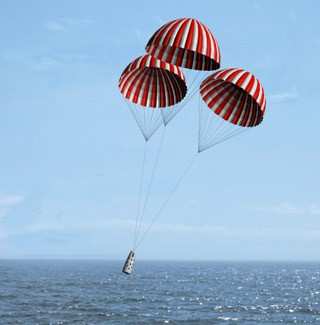Countdown To The X-Prize Cup, Of Course...
By Aero-News Senior Correspondent Kevin R.C. "Hognose"
O'Brien
One of the coolest things about the original X-Prize was the
sheer breadth of innovation it spawned, the colorful variety of
responses people had to the challenge of a reusable suborbital
space vehicle. Many commentators noted the unconventionality of the
ultimate winner, the SpaceShipOne/White Knight combination, which
resembled the Mercury/Maya combination of a bygone day in concept,
but added a bunch of new wrinkles, most importantly "shuttlecock
recovery" or as Burt Rutan calls it, "carefree reentry." (By the
way, the idea came to Burt as he woke in the middle of the
night).

But the other contestants were, generally, just as interesting.
There were the Canadians who started with a known quantity -- the
German V-2, first flown in 1942, and never conceived as a
man-rated, let alone recoverable, vehicle. Practically speaking, it
was a round of artillery ammunition with a dreadfully long range --
so the project of turning that disposable weapon into a reusable
space transport was (and is) fascinating.
There was John Carmack's Armadillo Aerospace, which team had
solved a lot of problems in vertical take-off and landing, and
Brian Feeney's da Vinci Project. There were spaceplanes, and staged
rockets and single-stage rockets, and they landed on runways and
fields and lakes, and their designers were Britons and Romanians
and Argentines, and all in all it was a quite remarkable range of
people and concepts.
What a shame it was that the Prize would be won and all the
other technology left by the wayside!
But, as it happened, nothing was left by the wayside at all.
Even before the first X-Prize flight had been scheduled, the
X-Prize Foundation was working on the concept of an annual
competition, a gymkhana of space flight, and that became the
X-Prize Cup. Rich prizes -- and exposure to the entrepreneurs of
private spaceflight -- guarantee that we'll continue to have an
array of able designers and innovative designs. And -- not
coincidentally -- many of the original X-Prize contenders are still
hanging in there as Cup competitors.
The first X-Prize Cup competition will take place next year, but
this year, a preliminary event, "Countdown to the X-Prize Cup,"
will be stirring hearts, rattling brain-cases, and inducing
spontaneous grins. There will be a Space Expo, and that means, of
course, that some of the most interesting rocket teams will be
there. This is an incomplete list of who's there and what they're
doing; we'll start with the action guys and then move into the
static displays (and many teams that are not displaying are still
coming to participate in panels, etc).

Armadillo Aerospace: Flying (VTOL demonstrator)
Armadillo Aerospace will be flying their latest demonstrator.
This is the new LOX version. It's expected to fly two programs: one
of several short (15 second) hover flights, and one of controlled
flight to 200 ft. AGL and return for a safe landing. This
demonstrates the controllability of Armadillo's engine as well as
its high-tech stability and control capabilities.

Golden Palace/Da Vinci Project: Flying (Capsule
Drop/Recovery)
The space capsule developed by Brian Feeney's Da Vinci Project
will be lifted to 10,000 ft. AGL by a helicopter (weather
permitting), and dropped, demonstrating the recovery technology Da
Vinci has developed, a precise sequence of freefall, drogues,
chutes, and airbags.
There will also be a capsule on static display.

Starchaser Industries PLC: Rocket Demonstration
Starchaser will be firing their 7,000 lb thrust engine (some of
the information says it's 5,000 lbst. We'll try to clear this up).
They'll also have the Thunderstar capsule on static display. The
Thunderstar Capsule is the people-carrying component of a 2-stage
plus-escape-gantry stack. Starchaser has developed their own rocket
engines as well as rockets; the first stage is powered by two
30,000 lbst Churchill Mk III engines.
Starchaser is based in Manchester, England, but has just
acquired offices in New Mexico this year. It is a privately held
company.

XCOR Aerospace: Flying (EZ-Rocket)
XCOR's EZ-Rocket, the forerunner of the Rocket Racing League's
upcoming Mark I racers, will fly. There was initial information
that Rick Searfoss would attempt to break a world record with the
rocket plane; that no longer appears in press materials for the
EZ-Rocket. The EZ-Rocket is important as a demonstrator of XCOR's
safe, reliable engine technology, and also as a teaser for the
upcoming Rocket Racing League. The EZ-Rocket last flew for the
public in 2002.
There are many interesting facts about XCOR, too many to print,
but here's one: while people often refer to them as X-Prize
competitors, XCOR never had an entry in the contest. XCOR's Jeff
Greason told Aero-News last year that they cheerfully would have
built a spacecraft for the contest if someone had contracted them
to do so, but no one did.

Tripoli Rocketry Association: Flying (Amateur Rockets)
Along with these new-technology manned spaceflight
demonstrations, the venerable fraternity of amateur rocketry, in
the form of the Tripoli Rocketry Association, will do their thing.
Tripoli is made up of almost 4,000 amateur rocketeers, organized
into local clubs or "prefectures." Tripoli members' rockets fall in
size and performance between the "model rockets" most of us know,
and the professional sounding rockets that are used by science and
industry. Which means, they make quite a spectacle! One of the
Tripoli launches is intended reach 35,000 feet AGL.
Unfortunately this middle ground of amateur rocketry has been
under attack by the Federal Bureau of Alcohol, Tobacco, Firearms
and Explosives, which has declared the ammonium perchlorate
composite component used in solid model rocket engines an
"explosive"; Tripoli and another association, the National
Association of Rocketry, are fighting this in court; if they lose,
you may not be able to see a launch like this again.
 ANN's Daily Aero-Linx (04.15.24)
ANN's Daily Aero-Linx (04.15.24) Classic Aero-TV: 'No Other Options' -- The Israeli Air Force's Danny Shapira
Classic Aero-TV: 'No Other Options' -- The Israeli Air Force's Danny Shapira Aero-News: Quote of the Day (04.15.24)
Aero-News: Quote of the Day (04.15.24) Airborne 04.16.24: RV Update, Affordable Flying Expo, Diamond Lil
Airborne 04.16.24: RV Update, Affordable Flying Expo, Diamond Lil ANN's Daily Aero-Term (04.16.24): Chart Supplement US
ANN's Daily Aero-Term (04.16.24): Chart Supplement US








